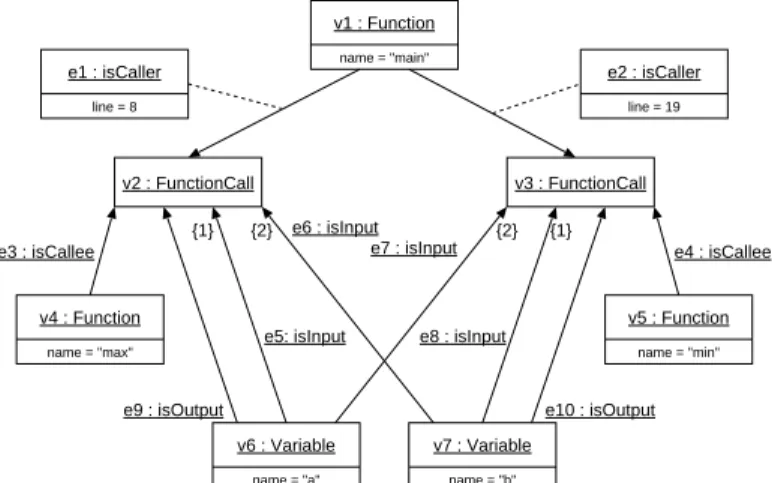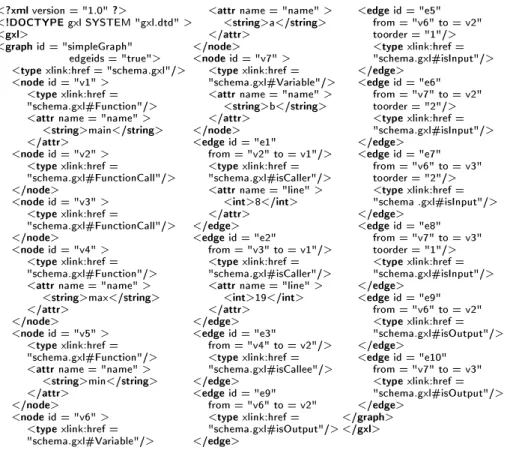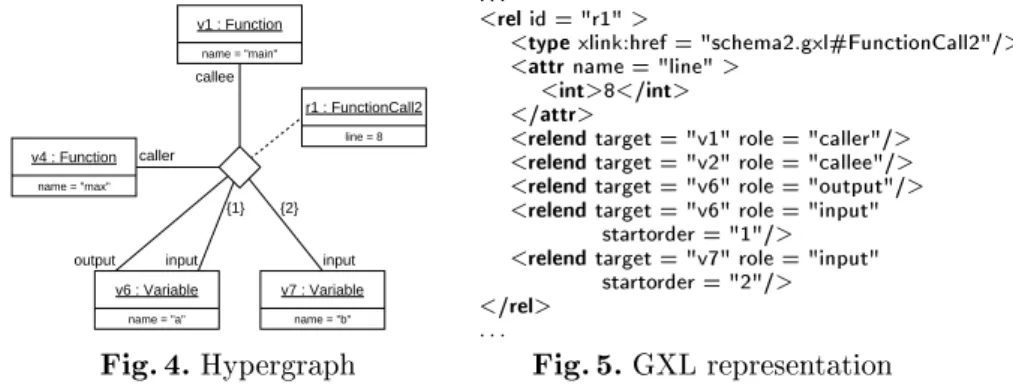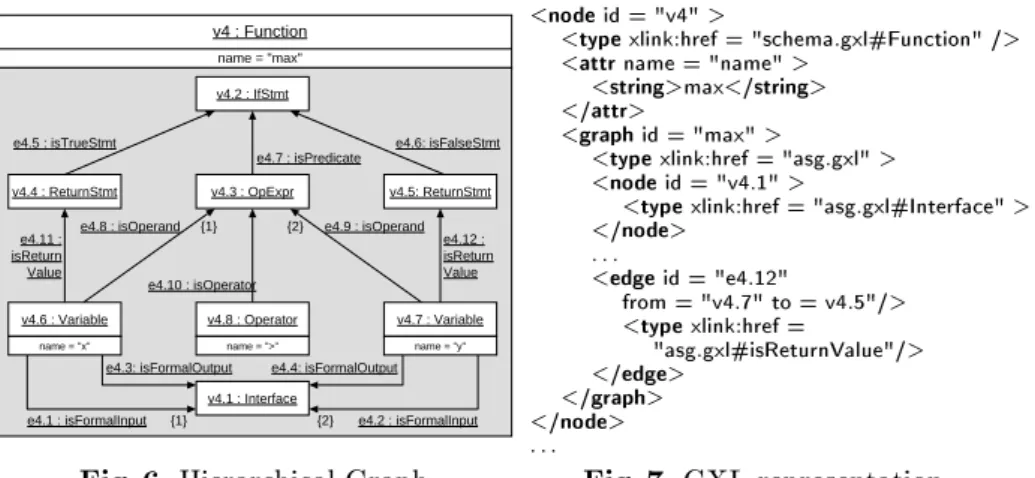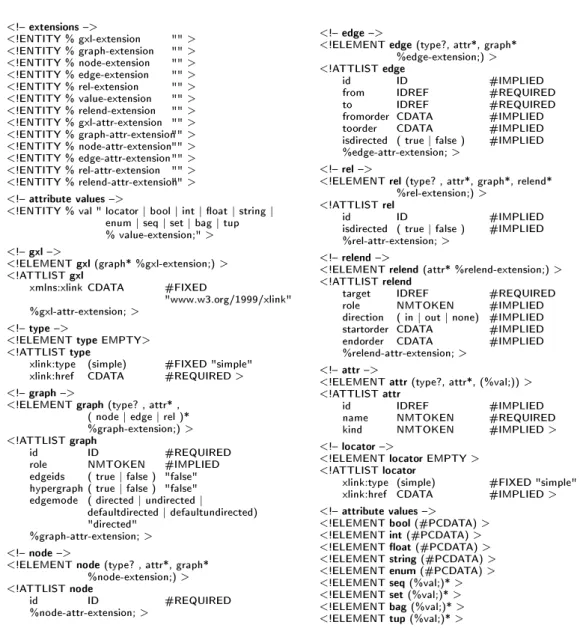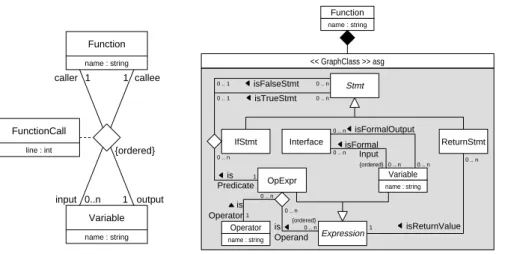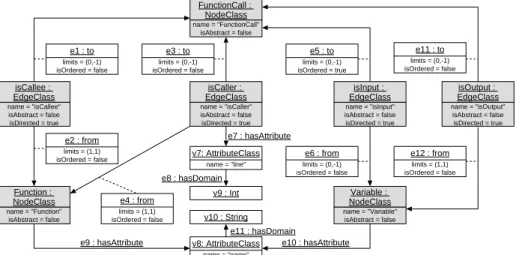Exchanging Graphs with GXL
AndreasWinter
UniversitätKoblenz-Landau,InstitutfürSoftwaretechnik
D-56016Koblenz,Postfach201602
mailto:winter@uni-koblenz.de
http://www.gupro.de/winter
Abstract. GXL(GrapheXchangeLanguage)isdesignedtobeastan-
darddataexchangeformatfor graph-basedtools.GXLisdenedasan
XMLsublanguage, whichoerssupportfor exchanginginstancegraphs
togetherwiththeirappropriateschemainformationinauniformformat.
Formally,GXL isbased ontyped,attributed, directed, orderedgraphs
which are extended by concepts to represent hypergraphs and hierar-
chical graphs. Using this general graphmodel, GXL oers a versatile
supportforexchangingnearlyallkindsofgraphs.
1 Motivation and Background
A great variety of software tools relies on graphsas internal data representa-
tion.A standardizedlanguageforexchangingthosegraphsoersarst stepin
improvinginteroperabilitybetweenthesetools.Insoftwarereengineering,forin-
stance,various graph-basedtoolsareused. Theseinclude extractors (e.g.scan-
ner, parser), abstractors (e.g. query tools, structure recognition tools, slicing
toolsetc.),andvisualizer(e.g.graphanddiagramvisualizer,codebrowser).Cur-
rently,thesetoolcomponentsareusedmoreorlessindependently.[29]givesan
overviewonexistingcombinationsoftoolsusedinvariousreengineeringprojects.
Usingacommongraphinterchangeformat,thesetoolscanbecomposedtobuild
agenraland powerfulreengineeringworkbench.
ThedevelopmentofGXL (Graph eXchange Language) originallystarted to
support data interoperabilitybetweenreengineeringtools.But sinceGXL was
developed as a generalformat for describing graph structures, it is applicable
in further areasoftoolinteroperability.Especially, GXL isused to supportin-
teroperabilitybetweengraphtransformationsystems[45]orgraphvisualization
systems.Now,theworkonGXLaimsatoeringageneralexchange formatfor
graph-basedtools.
ExchanginggraphswithGXLdealswithboth,instancegraphsandtheircor-
respondinggraphschemas.Firstly,GXLoersaversatilesupportforexchanging
all kinds of data based on typed, attributed, directed, ordered graphs including
hypergraphs and hierarchical graphs. Secondly, GXL oers means for exchang-
ing graphschemas representingthe graphstructure i.e. thedenition of node
andedgeclasses,theirattributeschemasandtheirincidencestructure.Both,in-
stancegraphsandgraphschemas,areexchangedbyXMLdocuments(Extended
MarkupLanguage)[47].
?
c
SpringerVerlag:P.Mutzel(ed.) GraphDrawing -9thInterationalSymposium,
of GXLto exchangeinstance graphsare introduced insection 3.Thelanguage
denition ofGXLis givenbyitsXMLdocumenttypedenition (DTD)in sec-
tion 3.4. Section 4describesthe exchange of graph schemas. The current and
intendedusageofGXLissummarizedin section5.
Moreinformation on GXL canbefound in [29] and[27]. Up-to-date infor-
mation includingtutorials and further GXL documents arecollected at http:
//www.gupro.de/GXL.
2 Genealogy of GXL
GXLoriginatedinamergerofGRApheXchangeformat(GraX)[10],TupleAt-
tributeLanguage(TA)[26],andthegraphformatofthePROGRESgraphrewrit-
ingsystem[41].Thegraphmodelresultingfrom thismergerwassupplemented
byadditionalconceptstohandlehierarchicalgraphsandhypergraphs.Further-
more,GXLincludesideasfromcommonexchangeformatsusedinreengineering,
includingATerms[46],RelationPartitionAlgebra(RPA)[36],andRigiStandard
Format(RSF)[52].Furtherfeatures fromXML-basedexchangeofgraphtrans-
formation systems, developed by groups in Barcelona, Berlin, Budapest, and
Kent[22]wereincludedintoGXL.ThedevelopmentofGXLwasalsoinuenced
byvariousformatsusedingraphdrawinge.g.daVinci[13],GML/Graphlet [18],
GRL [33] XGMML [53], and GraphXML [25]. Thus, GXL covers most of the
importantgraphformats.Itcanbeviewedasageneralizationoftheseformats.
ThegenealogyofGXL isdepictedin gure2.
WoSEF 2000
APPLIGRAPH meeting on exchange formats for Graph Transformation Graph Drawing workshop on data exchange formats (GD 2000) CASCON 2000 WCRE 2000 Dagstuhl 2001
"Interoperability of Reengineering Tools"
GraX
GXL 0.4.2
PROGRES TA
RPA RSF ATerms
GXL 0.6.6
GXL 0.7 GraphXML
Barcelona Berlin Budapest
Kent WCRE 1999
AlGra 2000 GROOM 2000
GXL 0.7.2
GXL 1.0 daVinci
GML Graphlet
GML XGMML
Fig.1.GenealogyofGXL
ThedevelopmentofGXLwasadvancedduringvariousconferencesandwork-
shopssince1998.Firsteortsondening ageneralexchangeformatforreengi-
WCRE 1999 [50], AlGra 2000 [1], and GROOM 2000 [20]. These discussions
resulted in the rst version of GXL, which was presented at the ICSE 2000
workshop on standard exchange formats (WoSEF 2000) [43]. Subsequent ver-
sions were discussed and compared to similar approaches from related areas
at the APPLIGRAPH meeting for exchangeformats for graphtransformation
systems[22] andthe GraphDrawing2000 workshop onexchangeformats [16].
Improvementsof these versions werepresentedin CASCON2000tutorials [28]
andworkshops[44]andduringtheWCRE2000exchangeformatsworkshop[31].
GXL (version 1.0) was ratied as standard exchange format in software
reengineeringattheDagstuhlSeminar"InteroperabilityofReengineeringTools"
in January2001[7]. Current work dealswith gatheringexperiences with GXL
version1.0andprovidingtoolsupportforworkingwithGXL.
3 Exchanging Graphs
Duetotheirmathematicalfoundationandalgorithmicpower,graphsareacom-
mondatastructureinsoftwareengineering.Dierentgraphmodelse.g.directed
graphs,undirectedgraphs,nodeattributedgraphs,edgeattributedgraphs,node
typed graphs, edge typed graphs, ordered graphs, relational graphs, acyclic
graphs,trees, etc. orcombinationsof these graphmodelsare utilized in many
software systems.Tosupport interoperability of graph-based tools, the under-
lying graph model has to be asrich as possible to covermost of these graph
models.
Such a common graph model is given by typed, attributed, directed, or-
deredgraphs(TGraphs)[9],[10].TGraphsaredirectedgraphs,whosenodesand
edges may be attributed and typed. Each type can be assigned an individual
attributeschemaspecifyingthepossibleattributesofnodesandedges.Further-
more,TGraphsareordered,i.e.thenodeset,theedgeset, andthesetsofedges
incident to a node have a total ordering. This ordering givesmodeling power
todescribesequencesofobjects(e.g.parameterlists)andfacilitatestheimple-
mentationofdeterministicgraphalgorithms.InapplyingTGraphstotheother
graphmodels,notallpropertiesofTGraphshavetobeusedtotheirfullextent.
These graph models canbeviewed asspecializations of TGraphs.Exchanging
typed,attributed,directed,orderedgraphsortheirspecializationswithGXLis
introducedinsection3.1
Tooersupport for hypergraphs andhierarchical graphs,TGraphswereex-
tended by n-ary edges and by nodes and edges containing lowerlevelgraphs.
GXL languageconstructs for exchanging hypergraphs and hierarchical graphs
are sketched in section 3.2 and 3.3. The complete GXL languagedenition is
givenin section3.4in termsofaXMLdocumenttypedenition.
3.1 Exchanging typed, attributed,directed,ordered graphs
Theobjectdiagram(cf.[40])ingure2showsanodeandedgetyped,nodeand
in line 8 and function b =min(b;a) in line 19. Thefunctions main, max and
min arerepresentedbynodesoftypeFunction.Thesenodesareattributedwith
thefunctionname.FunctionCall nodesrepresentthecallsoffunctionsmax and
min. They are associated to the caller by isCaller edges and to the callee by
isCallee edges.isCaller edges are attributed with aline attribute showingthe
linenumberwhichcontainsthecall.Inputparameters(representedbyVariable
nodes that are attributed with the variable name) are associated by isInput
edges. The ordering of parameter lists is given by ordering the incidences of
isInput edges pointing to FunctionCall nodes. The rst edge of type isInput
incidenttofunctioncallv2 (modelingthecallofmax(a,b))comesfromnodev6
representingvariablea.ThesecondedgeoftypeisInputconnectstothesecond
parameterb (nodev7).TheincidencesofisInput edgesassociatedwithnodev3
model thereversedparameterorder.Outputparametersareassociatedtotheir
function callsbyisOutput edges.
v1 : Function name = "main"
v4 : Function name = "max"
v6 : Variable name = "a"
v7 : Variable name = "b"
v5 : Function name = "min"
v2 : FunctionCall v3 : FunctionCall
e1 : isCaller line = 8
e2 : isCaller line = 19
e3 : isCallee e4 : isCallee
e6 : isInput e7 : isInput
e5: isInput e8 : isInput {1}
{1} {2} {2}
e9 : isOutput e10 : isOutput
Fig.2.typed,attributed,directed,orderedgraph
Exchanginggraphsliketheonein gure2requires languageconstructsfor
representing nodes, edges and their incidence relation. Furthermore, support
for describing type information, attribute values, and ordering information is
needed.
Figure 3depicts thegraph from gure2 asGXL document. The complete
grammarforthesedocumentsisgiveninsection3.4.XMLdocumentsstartwith
specifyingtheXML versionandtheunderlying documenttypedenition, here
"gxl.dtd". The body of a GXL document is enclosed in
<gxl>
tags. The GXL
document in gure 3 contains one graph, enclosed in
<graph>
tags, with an
uniqueidentier"simpleGraph".Thegraphreferstoitsassociatedgraphschema
(cf. section 4) stored in le schema.gxl. GXL supports both, graphswith edges
havingauniqueobjectidentier,andgraphswithunnamededges.Theattribute
<!DOCTYPEgxlSYSTEM"gxl.dtd">
<gxl>
<graphid="simpleGraph"
edgeids="true">
<typexlink:href="schema.gxl"/>
<nodeid="v1">
<typexlink:href=
"schema.gxl#Function"/>
<attr
name="name"
>
<string>main</string>
</attr>
<node
id="v2"
>
<type
xlink:href=
"schema.gxl#FunctionCall"/>
</node>
<node
id="v3"
>
<type
xlink:href=
"schema.gxl#FunctionCall"/>
</node>
<node
id="v4"
>
<typexlink:href=
"schema.gxl#Function"/>
<attrname="name">
<string>max</string>
</attr>
</node>
<nodeid="v5">
<typexlink:href=
"schema.gxl#Function"/>
<attrname="name">
<string>min</string>
</attr>
</node>
<node
id="v6"
>
<type
xlink:href=
"schema.gxl#Variable"/>
<string>a</string>
</attr>
</node>
<nodeid="v7">
<typexlink:href=
"schema.gxl#Variable"/>
<attrname="name">
<string>b</string>
</attr>
</node>
<edge
id="e1"
from="v2"to= v1"/>
<type
xlink:href=
"schema.gxl#isCaller"/>
<attr
name="line"
>
<int>8</int>
</attr>
</edge>
<edge
id="e2"
from="v3"to= v1"/>
<typexlink:href=
"schema.gxl#isCaller"/>
<attrname="line">
<int>19</int>
</attr>
</edge>
<edgeid="e3"
from="v4"to=v2"/>
<typexlink:href=
"schema.gxl#isCallee"/>
</edge>
<edge
id="e9"
from="v6"to=v2"
<type
xlink:href=
"schema.gxl#isOutput"/>
</edge>
from="v6"to=v2"
toorder="1"/>
<typexlink:href=
"schema.gxl#isInput"/>
</edge>
<edgeid="e6"
from="v7"to=v2"
toorder="2"/>
<type
xlink:href=
"schema.gxl#isInput"/>
</edge>
<edge
id="e7"
from="v6"to=v3"
toorder=
"2"/>
<type
xlink:href=
"schema
.gxl#isInput"/>
</edge>
<edge
id="e8"
from="v7"to=v3"
toorder=
"1"/>
<typexlink:href=
"schema.gxl#isInput"/>
</edge>
<edgeid="e9"
from="v6"to=v2"
<typexlink:href=
"schema.gxl#isOutput"/>
</edge>
<edgeid="e10"
from="v7"to=v3"
<type
xlink:href=
"schema.gxl#isOutput"/>
</edge>
</graph>
</gxl>
Fig.3.GXLrepresentationofgraphfromgure2
Nodes and edges of a given graph are exchanged by <node> and <edge>
elementswhich can be addressedby their identier attribute. Incidence infor-
mation of edges including edge orientation is stored in from and to attributes
within
<edge>
tags.Orderingofincidencesisalsomodeledhere.Attributesfro-
morderand toorder representthe position of anedge in theincidence list of its
startandtargetnode.Nodeandedgetypesarerepresentedbylinkspointingto
theappropriateschemainformation.This linkisenclosedin
<type>
tags.
<node>
and
<edge>
elementsmayadditionallycontainfurtherattributein-
formation.
<attr>
elementsdescribeattribute name andvalue. LikeOCL [48],
GXL provides
<bool>, <int>, <oat>,
and
<string>
attributes. Furthermore,
enumeration values
(<enum>)
and URI-references
(<locator>)
pointing to ex-
ternallystoredobjectsaresupported.Attributevaluesmightbesubstructured.
Here,GXLoerscompositeattributeslikesequences(<seq>),sets(<set>),multi
sets(<bag>),andtuples(<tup>).
3.2 Exchanging Hypergraphs
Inadditiontographs,GXLprovidestheexchangeofhypergraphs.Hypergraphs[3]
undirected,orderedhypergraphs.
Figure 4shows ahypergraph in UML notation, modeling the function call
a=max(a;b)bya5-aryhyperedgeoftypeFunctionCall2.Thediamond,repre-
sentingthehyperedge,isconnectedbyundirectedlines(tentacles)toitsrelated
Function-and Variable-nodes.These tentaclesare markedwith roles, identify-
ingcaller, callee,input,andoutput.Numbersdescribingtheorderofincidences
of tentaclesaccordingthehyperedge,indicate theordering ofparameters.Like
edgee1 ingure2,thehyperedgeisattributedwithaline attribute.
TheGXL representation ofthis hyperedgeis given in gure5. Hyperedges
arerepresentedby<rel>elements(relation).Like<node>and<edge>elements,
<rel>
elementscan contain type
(<type>)
and attribute
(<attr>)
information.
Tentacles,which pointto therelatedgraphobjects(target),arerepresentedby
<relend>
subelements (relation end). Roles of tentacles are stored in role at-
tributes. Incidences accordingto thehyperedgeare exchangedbystartorder at-
tributes.Theorderingoftentaclesaccordingtheirtargetobjectscanbemodeled
byendorderattributes.Directed orundirectedhyperedgesandtentaclesare dis-
tinguishedbyattributesisdirectedanddirection(cf.theGXLDTDinsection3.4).
v1 : Function name = "main"
v4 : Function name = "max"
v6 : Variable name = "a"
v7 : Variable name = "b"
r1 : FunctionCall2 line = 8 callee
input input
{1} {2}
caller
output
Fig.4.Hypergraph
...
<rel
id="r1"
>
<type
xlink:href=
"schema2.gxl#FunctionCall2"/>
<attr
name="line"
>
<int>8</int>
</attr>
<relend
target="v1"role=
"caller"/>
<relend
target="v2"role=
"callee"/>
<relendtarget="v6"role="output"/>
<relendtarget="v6"role="input"
startorder="1"/>
<relendtarget="v7"role="input"
startorder="2"/>
</rel>
...
Fig.5.GXL representation
Edgescan be viewedas2-ary hyperedges.Thus, in GXL, edge information
canberepresentedby binary hyperedges. Sincegraphswith (binary)edges are
widespreadin softwareengineering and mostapplications dealwithgraphsin-
stead ofhypergraphs,GXL oersboth,theelement<rel>forhyperedges,and,
asashortcutforbinaryhyperedges,<edge>elements.
3.3 Exchanging Hierarchical Graphs
Graphs gather their popularity from their mathematical foundation and their
visualcapabilitiestoexpresscomplexcontexts.However,duetotheirsize,large
graphs become bulky and dicult to understand. This complexity can be re-
duced by structuringgraphs. Parts of graphsrepresenting related objectscan
begroupedtogetherto form encapsulated,higherlevelstructures. Hierarchical
graphs[4]support structuringgraphsbygroupingandencapsulation.
Figure 6 depicts a hierarchical graph. Node v4 (cf. gure 2) contains a
v4 : Function name = "max"
v4.4 : ReturnStmt
e4.7 : isPredicate
{1} {2}
v4.5: ReturnStmt
v4.6 : Variable name = "x"
v4.8 : Operator name = ">"
v4.7 : Variable name = "y"
v4.3 : OpExpr v4.2 : IfStmt
v4.1 : Interface
e4.1 : isFormalInput e4.2 : isFormalInput
e4.9 : isOperand e4.8 : isOperand
e4.10 : isOperator
{1} {2}
e4.11 : isReturn Value
e4.12 : isReturn Value e4.6: isFalseStmt e4.5 : isTrueStmt
e4.3: isFormalOutput e4.4: isFormalOutput
Fig.6.HierarchicalGraph
<node
id="v4"
>
<type
xlink:href="schema.gxl#Function"
/>
<attr
name="name"
>
<string>max</string>
</attr>
<graphid="max">
<typexlink:href="asg.gxl">
<nodeid="v4.1">
<typexlink:href="asg.gxl#Interface">
</node>
...
<edgeid="e4.12"
from="v4.7"to=v4.5"/>
<type
xlink:href=
"asg.gxl#isReturnValue"/>
</edge>
</graph>
</node>
...
Fig.7.GXLrepresentation
of function max. The GXL representation in gure 7 shows this subgraph as
<graph> subelement of node v4.Subgraphs associated to edges or hyperedges
areexchangedanalogously(cf.theGXLDTD insection3.4).
Thisrepresentationforhierarchicalgraphsworksforthosehierarchicalgraphs
with strong ownership for each graphobject. This representationalso permits
edgesandhyperedgescrossingtheboundariesofgraphhierarchies.Thoseedges
arecontainedintheleast-common-ancestor-graph.
Sincenogeneralmodelforhierarchicalgraphsexistssofar(cf.[4]),GXLpro-
videsfurthersupportforexchanginggraphhierarchies.Alternatively,references
to subgraphs and their elements can be exchanged using <locator> attributes
pointing to their appropriate GXL representation. Further support might be
oered in a next GXL version by graph-valued attributes orby special edges,
representinghierarchy.
3.4 GXL DocumentType Denition
The language features of GXL for exchangingtyped, attributed, directed, or-
deredgraphs,hypergraphs,andhierarchicalgraphsaresummarizedinaconcep-
tualmodeldeningthegraphmodelsupportedbyGXL.TheGXLgraphmodel
iscompletely describedat http://www.gupro.de/GXL/(graph model) withits
graphstructure partanditsattributepart.
Since GXL is a XML sublanguage, the GXL graph model had to betran-
scribed into a XML document type denition (DTD) oran appropriate XML
schema denition. Tokeep GXL simple and less verbose, this translation was
donemanually. Theresulting DTD (cf. gure8,a commented versionis given
athttp://www.gupro.de/GXL(DTD))requiresonly18XML elements.Incon-
trast, an appropriate DTD generated with IBMs XMI Toolkit [30] according
theXMLMetadataInterchange(XMI)principlesfordevelopingDTDs[35,sec-
tion 3]requires 66elementsfor the GXL coreand andadditional 63 elements
extensions
<!ENTITY
%gxl-extension ""
>
<!ENTITY
%graph-extension ""
>
<!ENTITY
%node-extension ""
>
<!ENTITY
%edge-extension ""
>
<!ENTITY
%rel-extension ""
>
<!ENTITY
%value-extension ""
>
<!ENTITY
%relend-extension ""
>
<!ENTITY
%gxl-attr-extension ""
>
<!ENTITY
%graph-attr-extension""
>
<!ENTITY%node-attr-extension"">
<!ENTITY%edge-attr-extension"">
<!ENTITY%rel-attr-extension "">
<!ENTITY%relend-attr-extension"">
<!attributevalues>
<!ENTITY%val"locatorjbooljintjoatjstringj
enumjseqjsetjbagjtup
%value-extension;">
<!gxl>
<!ELEMENT
gxl(graph*%gxl-extension;)
>
<!ATTLIST
gxl
xmlns:xlink CDATA #FIXED
"www.w3.org/1999/xlink"
%gxl-attr-extension;
>
<!
type
>
<!ELEMENT
type
EMPTY>
<!ATTLIST
type
xlink:type (simple) #FIXED"simple"
xlink:href CDATA #REQUIRED
>
<!
graph
>
<!ELEMENT
graph(type?,attr*,
(nodejedgejrel)*
%graph-extension;)>
<!ATTLISTgraph
id ID #REQUIRED
role NMTOKEN #IMPLIED
edgeids (truejfalse) "false"
hypergraph(truejfalse) "false"
edgemode (directedjundirectedj
defaultdirectedjdefaultundirected)
"directed"
%graph-attr-extension;>
<!
node
>
<!ELEMENT
node(type?,attr*,graph*
%node-extension;)
>
<!ATTLIST
node
id ID #REQUIRED
%node-attr-extension;
>
<!
edge
>
<!ELEMENT
edge(type?,attr*,graph*
%edge-extension;)
>
<!ATTLIST
edge
id ID #IMPLIED
from IDREF #REQUIRED
to IDREF #REQUIRED
fromorder CDATA #IMPLIED
toorder CDATA #IMPLIED
isdirected (truejfalse) #IMPLIED
%edge-attr-extension;>
<!rel>
<!ELEMENTrel(type?,attr*,graph*,relend*
%rel-extension;)>
<!ATTLISTrel
id ID #IMPLIED
isdirected (truejfalse) #IMPLIED
%rel-attr-extension;>
<!relend>
<!ELEMENT
relend(attr*%relend-extension;)
>
<!ATTLIST
relend
target IDREF #REQUIRED
role NMTOKEN #IMPLIED
direction (injoutjnone) #IMPLIED
startorder CDATA #IMPLIED
endorder CDATA #IMPLIED
%relend-attr-extension;
>
<!
attr
>
<!ELEMENT
attr(type?,attr*,(%val;))
>
<!ATTLIST
attr
id IDREF #IMPLIED
name NMTOKEN #REQUIRED
kind NMTOKEN #IMPLIED>
<!locator>
<!ELEMENTlocatorEMPTY>
<!ATTLISTlocator
xlink:type (simple) #FIXED"simple"
xlink:href CDATA #IMPLIED>
<!attributevalues>
<!ELEMENTbool(#PCDATA)>
<!ELEMENT
int(#PCDATA)
>
<!ELEMENToat(#PCDATA)>
<!ELEMENT
string(#PCDATA)
>
<!ELEMENT
enum(#PCDATA)
>
<!ELEMENT
seq(%val;)*
>
<!ELEMENT
set(%val;)*
>
<!ELEMENT
bag(%val;)*
>
<!ELEMENT
tup(%val;)*
>
Fig.8.GXL DocumentTypeDenition
4 Exchanging Graph Schemas
Graphs onlyoer aplain structured meansfor describingobjects(nodes) and
their interrelationship (edges, hyperedges). Graphs have no meaning of their
own.Themeaningofgraphscorrespondstothecontextinwhichtheyareused
andexchanged.Theapplicationand interchangecontextdetermines
whichnode,edge,andhyperedgeclassesareused,
whichrelationsexistbetweennodes,edges,andhyperedgesofgivenclasses,
whichadditionalconstraints(likeorderingofincidences,degree-restrictions
etc.)havetobecomplied.
This schematicdata canbedescribedbyconceptual modeling techniques. Class
diagramsoerasuiteddeclarativelanguagetodenegraphclasseswithrespect
toagivenapplicationorinterchangecontext[10].
4.1 Describing graph classesby class diagrams
InGXLgraphclassesaredenedbyUMLclassdiagrams[40].Figure9showsa
graphschemadeningclassesofgraphsliketheonegiveningure2.Nodeclasses
(FunctionCall,Function,and Variable) aredened byclasses.Edgeclasses(is-
Callee,isInput,andisOutput)aredenedbyassociations.Attributededgeclasses
(isCaller)aredescribedbyassociatedclasses.Likeclasses,theycontaintheas-
sociated attribute structures. The orientation of edges is depicted by a lled
triangle (cf. [40, p. 155]. Since most of the available UML tools do not oer
this UMLconstruct, directed arrows(depictingvisibilityin original UML)can
be used alternatively (cf. gure 13). Multiplicities denote degree restrictions.
Orderingofincidencesisindicatedbythekeyword{ordered}.
Function
name : string
Variable
name : string
FunctionCall isCallee
0 ..*
1
1
0 ..* 0 ..*
0 ..*
isCaller
line : int {ordered}
isCaller
isInput
isOutput
1 0 ..*
Fig.9.Graph-Schema
In asimilar way, UML class diagrams oer language constructs to specify
classesofhypergraphsandhierarchicalgraphs.Figure10showsaclassdiagram
dening hypergraphs liketheonein gure4.Classesofhyperedgesaredened
by n-ary associations depicted by a diamond. This diamond is connected by
links to the related node classes. These links can be annotated by multiplic-
ity information to demand cardinalities, and by names indicating the role of
participating classes. The keyword {ordered} demands ordering of tentacles in
appropriateinstancegraphs.
ThedenitionofhierarchicalgraphsinUMLrequiresanadditionallanguage
constructrepresentinggraphclassesthemselves.Thestereotype<<GraphClass>>
distinguishesclassesrepresentinggraphclassesfromclassesdeningnodeclasses.
<<GraphClasses>>composeclassesand associationsto denethegraphschema
onthenextlevelofhierarchy.UMLprovidesanestednotationtorepresentthese
subschemaswithinthe<<GraphClass>>classes.Strong ownershipofsubgraphs
tographelementsisexpressedbycomposition(lleddiamond).Figure11denes
agraphclassforhierarchicalgraphsliketheone,depictedin gure6.Nodesof
ClassFunctioncontaingraphsofgraphclassasg.
To oer up-to-date conceptual modeling power,the GXL schema notation
Function name : string
Variable name : string FunctionCall
line : int
callee
input
{ordered}
caller
1
1 1
0..n output
Fig.10.Hypergraph-Schema
Function name : string
is Operand
Interface
isReturnValue
{ordered}
Stmt
Operator name : string
Variable name : string
Expression is
Predicate is Operator
isFormal Input isFormalOutput
0 .. n 0 .. n
0 .. 1 isTrueStmt
isFalseStmt
0 .. 1
1 0 .. n
0 .. n 0 .. n
0 .. n
0 .. n
IfStmt
1 0 .. n
OpExpr
0 .. n
0 .. n
{ordered}
ReturnStmt
1
0 .. n
<< GraphClass >> asg
Fig.11.HierarchicalGraph-Schema
aggregation and composition by using the appropriate UML notation (cf. the
denition of<<GraphClass>> asg ingure11.
4.2 Describing graph classesby graphs
SinceUML classdiagrams arestructuredinformation themselves,theymay be
representedasgraphsaswell.ForexchanginggraphschemasinGXL,UMLclass
diagrams are transfered into equivalent graph representations. Thus, instance
graphsand schemasare exchangedwiththe same type of document,i.e. XML
documentsmatchingtheGXLDTD (cf.section3.4).
Figure12depicts thetransformationof theclassdiagram in gure9intoa
nodeandedgetyped,nodeandedgeattributed,directedgraph.Node-,edge-and
hyperedge-classes,attributes and their domains are modeled by nodes of suit-
ablenodetypes.Theirattributesdescribefurtherproperties.Interrelationships
between surrogates of these classes are represented by edges of proper types.
Attribute information is associated with surrogates of node, edge, and hyper-
edge classesand associations byhasAttribute and hasDomain edges. from and
toedgesmodelincidencesofassociationsincludingtheirorientation.Multiplici-
tiesofassociationsarestoredinlimits-attributes.ThebooleanattributeisOrdered
indicatesordered incidences.
GXLdocuments,representinginstancegraphstoagivengraphschema,refer
tothosenodesoftheequivalentschemagraphrepresentingnodeclasses(Node-
Class), edge classes (EdgeClass) and hyperedge classes (RelClass). The nodes
representingtheseclass denitionsin gure12which arereferredby thegraph
in gure2areshaded.
Class diagrams dening hypergraphs or hierarchical graphs can be trans-
formedintographsanalogously.EachclassdiagramdeningaGXLgraphschema
can be transformed into a graph (schema graph) matching a suited schema,
representing GXL schema graphs. Schema graphs are instances of the GXL
sentingtheGXL metaschema,is aninstance ofitself, it isexchangedby aself
referringGXL document.
name = "isCallee"
isAbstract = false isDirected = true
name = "isInput"
isAbstract = false isDirected = true name = "isCaller"
isAbstract = false isDirected = true e1 : to
limits = (0,-1) isOrdered = false
name = "Function"
isAbstract = false
name = "Variable"
isAbstract = false v7: AttributeClass
name = "line"
v9 : Int
v8: AttributeClass name = "name"
v10 : String
e5 : to limits = (0,-1) isOrdered = true e3 : to
limits = (0,-1) isOrdered = false
e2 : from limits = (1,1) isOrdered = false
e4 : from limits = (1,1) isOrdered = false
e7 : hasAttribute
e8 : hasDomain
e9 : hasAttribute e10 : hasAttribute
e11 : hasDomain
name = "isOutput"
isAbstract = false isDirected = true e11 : to
limits = (0,-1) isOrdered = false
e6 : from limits = (0,-1) isOrdered = false
e12 : from limits = (1,1) isOrdered = false FunctionCall :
NodeClass name = "FunctionCall"
isAbstract = false
isCallee : EdgeClass
isCaller : EdgeClass
isInput : EdgeClass
isOutput : EdgeClass
Function : NodeClass
Variable : NodeClass
Fig.12.Graph-Schema(schemagraph)
IncontrasttothestrategyproposedbyXMLMetaDataInterchange(XMI)
[35],GXLschemasarenotexchangedbyXMLdocumentsaccordingtotheMeta
ObjectFacility(MOF)[34].XMI/MOFoersageneral,butveryverboseformat
for exchangingUML class diagrams as XML streams. Nextto itsexaggerated
verbosity, which contradicts the requirement for exchange formats of ascom-
pactaspossibledocuments,theXMI/MOFapproachrequiresdierenttypes of
documentsfor representingschema andinstance graphs. Especially in applica-
tionsdealingwithschemainformationoninstancelevel(e.g.intoolsforediting
and analyzing schemas), this leadsto the disadvantageof dierent documents
representing the same information, one on instance level (as XML document)
andoneonschemalevel(asXMLDTD).TheGXLapproachtreatsschemaand
instance informationin exactlythesameway.Schemaand instancegraphsare
exchangedaccordingthesameDTDgivenin gure8.
4.3 GXL Metaschema
TheGXLmetaschemadenesthesetofgraphsrepresentingcorrectGXLschema
graphs.Theclassdiagramin gure13showsthegraphpartoftheGXLmeta-
schema.Thisgraphclassprovidesconstructstodeneclassesofgraphelements
i.e.nodes(NodeClass),edges(EdgeClass),andhyperedges(RelClass)includingtheir
interrelationships. Their attributes distinguish abstract classes, classes of di-
rectedorundirectededgesorhyperedgesorcontainmultiplicityconstraintsetc.
To express associated attribute structures GraphElementClasses can be con-
nectedtoattributestructures(AttributedElementClass).Thedenitionofattribute
structuressupportsthestructured attributesusedinGXL includingthedeni-
andvalueparts,athttp://www.gupro.de/GXL/(metaschema)).Generalization
isprovidedforallGraphElementClassesbyisAedges.GraphElementClassescontaining
lowerlevelgraphsareassociatedto therepresentationof thelowerlevelGraph-
Classrepresentationbycontainsedges.TheGraphClasscontainsthosenode-,edge-,
andhyperedgeclassesrepresentingitsstructure.Aggregation(AggregationClass)
andcomposition(CompositonClass)aremodeledbyspecializationsofEdgeClasses.
5 Using GXL
AttheDagstuhlseminaron"InteroperabilityofReengineeringTools"GXLver-
sion1.0 wasratiedasthestandardexchange format insoftware reengineering
[7].Currently,variousgroupsinsoftware(re)engineeringareimplementingGXL
import and export facilities to their tools (e.g. Bauhaus [2], Columbus [11],
CPPX [6],Fujaba [14],GUPRO[23], PBS[37], RPA (PhilipsResearch),PRO-
GRES[38],Rigi[39],Shrimp[42]).Othersaregoingtoimplementtoolstosup-
portworkingwithGXL.Forinstance,aframeworkforGXLConverters[15]and
aXMI2GXLtranslator[54]arebeingdevelopedatUniv.BWMünchen.Further
activities deal with providing graph query machines (GReQL, Univ. Koblenz)
toGXL graphsorGXL-basedgraphdatabases(Univ.Aachen).
AnimportantfeatureofGXLisitssupportforexchangingschemainforma-
tion.Basedonthiscapability,referenceschemasforcertainstandardapplications
in reengineeringare currentlyunder development. These activitiesaddressref-
C++[6],[12].
Furthermore,groupsdevelopinggraphtransformationtools(e.g.GenSet[17],
PROGRES[38])orgraphvisualizationtools(e.g.GVF[24],Shrimp[42],yFiles
[55]) already use GXL or pronounced to use GXL. At University of Toronto,
GXL is applied within anundergraduate software engineering courseto create
agrapheditor/layouter[8].
GXL also serves as foundation to dene further graph oriented exchange
formats.Thus,GXLdenesthegraphpartintheexchangeformatGTXL(Graph
TransformationeXchange Language)[21],[45]. Activitiesin thegraphdrawing
community also deal with the development of an exchange format for graphs
includinglayoutinformation[16].Thereis evidenceof combiningthestructure
partofGXLwiththegraphlayoutpartandthemodularizationpartofGraphML
[19]to formageneralandcomprehensivegraphexchangeformat.
6 Conclusion
The previous sections gave ashort introduction in the GXL Graph eXchange
Languageversion1.0and itscurrentapplication.
Summarizing,GXL oersanalready widelyused XML sublanguageforin-
terchangingtyped, attributed, directed,ordered graphsincluding hypergraphs
andhierarchicalgraphstogetherwiththeirappropriateschemas.Byfocusingon
graphstructure,GXLcontributesthecorefordeningafamilyofspecialsuited
graphexchange formats.
Acknowledgment.I would liketo thank theGXL co-authorsRichard C.
Holt,AndySchürr,andSusanElliottSimforvariousfruitfuldiscussionsonthe
development of GXL, Jürgen Ebert, Bernt Kullbach, and Volker Riediger for
manyinterestingdiscussionsonTGraphs andGXL,andKevinHirschmannfor
implementingtheGUPROrelatedGXLtools.ThankstoallusersofGXL,who
currentlyapplying andtestingGXL 1.0in theirtools.Theirexperiencewill be
animportantaidto improveGXL.
References
1. WorkshoponAlgebraicandGraph-TheoreticApproachesinSoftwareReengineer-
ing, Koblenz, February 28, 2000. http://www.uni-koblenz.de/~wi nter/ AlGra /
algra.html(14.9.2001).
2. Bauhaus:SoftwareArchitecture,SoftwareReengineering,ProgramUnderstanding.
http://www.informatik.uni-stutt gart. de/i fi/ps /bau haus/ (1.9.2001).
3. C.Berge. GraphsandHypergraphs. North-Holland,Amsterdam,2edition,1976.
4. G. Busatto. An Abstract Model of Hierarchical Graphs and Hierarchical
GraphTransformation(currentdraft). http://www.informatik.uni-brem en.de /
~giorgio/papers/phd-thesis.ps.g z (16.9.2001).
5. DataExchangeGroup,ConclusionsfromMeetingatCASCON1998,30.Nov1998.
(1.9.2001).
7. J.Ebert,K.Kontogiannis,J.Mylopoulos:InteroperabilityofReengineeringTools.
http://www.dagstuhl.de/DATA/Repo rts/ 01041 / (18.4.2001), 2001.
8. S.Easterbrook. CSC444F:Software EngineeringI(Fallterm2001),Universityof
Toronto. http://www.cs.toronto.edu/~sme/C SC44 4F/ (15.9.2001),2001.
9. J. Ebert and A. Franzke. A Declarative Approach to Graph Based Modeling.
In E. Mayr,G. Schmidt, and G. Tinhofer, editors. Graphtheoretic Concepts in
Computer Science,LNCS903. Springer,Berlin,pages3850.1995.
10. J.Ebert,B.Kullbach,andA.Winter.GraXAnInterchangeFormatforReengi-
neeringTools. In[50],pages8998.1999.
11. R.Ferenc,F.Magyar,Á.Beszédes,Á.Kiss,andM.Tarkiainen. Columbus-Tool
for Reverse Engineering Large Object Oriented Software Systems. In Proceed-
ings SPLST 2001, Szeged, Hungary (http://www.inf.u-szeged.hu/~ferenc/
research/ferencr_columbus.pdf, (1.9.2001)),pages1627.June2001.
12. R. Ferenc,S.Elliott Sim,R. C.Holt,R. Koschke,and T.Gyimòthy. Towards a
Standard Schemafor C/C++. Toappear in8thWorking Conferenceon Reverse
Engineering. IEEEComputerSoc.,2001.
13. M.FröhlichandM.Werner.daVinciV2.0.xOnlineDocumentation.http://www.
tzi.de/~davinci/docs/ (18.4.2001),June1996.
14. Fujaba:FromUMLtoJavaandbackagain. http://www.uni-paderborn.de/cs /
fujaba/(1.9.2001).
15. GCF-aGXLConverterFramework.
http://www2.informatik.unibw-mu enche n.de /GXL/ trie bsees /(1.9.2001).
16. Workshop on Data Exchange Formats, Graph Drawing 2000. http://www.cs.
virginia.edu/~gd2000/gd-satelli te.ht ml(14.9.2001),2001.
17. GenSet: Design Information Fusion. http://www.cs.uoregon.edu/res earch /
perpetual/dasada/Software/GenSet / (1.9.2001).
18. TheGMLFileFormat.
http://www.infosun.fmi.uni-pass au.de /Gra phlet /GML / (18.4.2001).
19. TheGraphMLFileFormat. http://www.graphdrawing.org/grap hml/
(31.8.2001), 2001.
20. 7-ter Workshop des GI-Arbeitskreises GROOM, UML - Erweiterungen und
Konzepte der Metamodellierung, 4.-5. April 2000, Universität Koblenz-Landau.
http://www2.informatik.unibw-mu enche n.de /GROO M/ME TA/ (14.9.2001).
21. GraphTransformationSystemExchange Language. http://tfs.cs.tu-berlin.
de/projekte/gxl-gtxl.html (18.08.2001).
22. First APPLIGRAPH meeting on GXL (graph exchange language) and GTXL
(graph transformation exchange language) Paderborn (September 5-6, 2000).
http://tfs.cs.tu-berlin.de/proj ekte/ gxl-gtxl /pade rbor n.htm l (11.9.2001).
23. GUPRO:GenericUnderstandingofPrograms.http://www.gupro.de/(1.9.2001).
24. GVF-GraphVisualizationFramework.http://www.cwi.nl/InfoVisu(1.9.2001).
25. I.HermanandM.S.Marshall. GraphXMLAnXMLbasedgraphinterchange
format. ReportINS-0009,CWI,Amsterdam,April2000.
26. R.C.Holt. AnIntroductiontoTA:TheTuple-AttributeLanguage.
http://plg.uwaterloo.ca/~holt/pa pers /ta.h tml (18.4.2001),1997.
27. R.C.Holtand A.Winter. AShortIntroductiontotheGXLSoftwareExchange
Format. In[51], pages299301.2000.
28. R.C.HoltandA.Winter.SoftwareDataInterchangewithGXL:Introductionand
Tutorial,CASCON 2000. http://www.cas.ibm.com/archives/ 2000 /work shops /
In[51],pages162171.2000.
30. XMIToolkit1.15. http://alphaworks.ibm.com/tec h/xm itool kit (1.9.2001).
31. K.Kontogiannis. ExchangeFormatsWorkshop. In[51],pages277301.2000.
32. T. Lethbridge, E. Plödereder, S.Tichelar,C. Riva,and P.Linos. The Dagstuhl
MiddleLevelModel(DMM). internalnote,2001.
33. F. Newbery Paulish. The Design of an Extendible Graph Editor, LNCS 704.
Springer,Berlin, 1991.
34. Meta Object Facility (MOF) Specication. http://www.omg.org/technology /
documents/formal/mof.htm (2.9.2001), March2000.
35. XML Meta Data Interchange (XMI) Specication. http://www.omg.org/
technology/documents/formal/xmi. htm (1.9.2001),November2000.
36. R. Ommering,L. vanFeijs, and R. Krikhaar. A relational approachto support
softwarearchitectureanalysis.SoftwarePracticeandExperience,28(4),pages371
400, April1998.
37. PBS:ThePortableBookshelf. http://swag.uwaterloo.ca/pbs/ (1.9.2001).
38. A Graph Grammar Programming Environment - PROGRES. http://www-i3.
informatik.rwth-aachen.de/resea rch/p roje cts/p rogr es/ (1.9.2001).
39. RIGI:avisualtoolforunderstandinglegacysystems.http://www.rigi.csc.uvic.
ca/(1.9.2001).
40. J.Rumbaugh,I.Jacobson, andG.Booch. TheUniedModeling LanguageRefer-
enceManual. AddisonWesley,Reading,1999.
41. A.Schürr,A.J.Winter,andA.Zündorf.PROGRES:LanguageandEnvironment.
InH.Ehrig,G.Engels,H.-J.Kreowski, andG.Rozenberg,editors. Handbook on
GraphGrammars,volume2. WorldScientic,Singapore,pages487550.1999.
42. ShriMPViews: simpleHierarchicalMulti-Perspective. http://www.shrimpviews.
com/(1.9.2001).
43. S.ElliotSim,R.C.Holt,and R.Koschke. ProceedingsICSE2000 Workshopon
StandardExchangeFormat(WoSEF). Technicalreport,Limerick,2000.
44. S.ElliottSim.SoftwareDataInterchangewithGXL:ImplementationIssues,CAS-
CON2000.http://www.cas.ibm.com/archives /2000 /wor kshop s/de scrip tions .
shtml\#17(14.9.2001), November13-16,2000.
45. G.Taenzer.TowardsCommonExchangeFormatsforGraphsandGraphTransfor-
mationSystems. InProceedingsUNIGRAsatelliteworkshopof ETAPS'01.2001.
46. M.vandenBrand,H.A.deJong,P.Klint,andP.A.Olivier. Ecientannotated
Terms. Software:Practice andExperience,30(3),pages259291,March2000.
47. ExtensibleMarkupLanguage(XML)1.0.W3crecommendation,W3CXMLWork-
ingGroup,http://www.w3.org/XML/ (17.4.2001),February1998.
48. J.B.WarmerandA.G.Kleppe. The ObjectConstraintLanguage:PreciseMod-
elingWithUML. Addison-Wesley,1998.
49. 5thWorkingConference onReverseEngineering. IEEEComputerSoc.,1998.
50. 6thWorkingConference onReverseEngineering. IEEEComputerSoc.,1999.
51. 7thWorkingConference onReverseEngineering. IEEEComputerSoc.,2000.
52. K. Wong. RIGI User'sManual, Version 5.4.4. http://www.rigi.csc.uvic.ca/
rigi/rigiframe1.shtml?Download (18.4.2001),30.June1998.
53. Extensible Graph Markup and Modeling Language). http://www.cs.rpi.edu/
~puninj/XGMML/ (19.8.2001),2001.
54. XIG -AnXSLT-basedXMI2GXL-Translator. http://ist.unibw-muenchen.de /
GXL/volk/(1.9.2001).
55. yFiles - Interactive Visualization of Graph Strucutres. http://www-pr.
informatik.uni-tuebingen.de/yfi les/ (1.9.2001).
